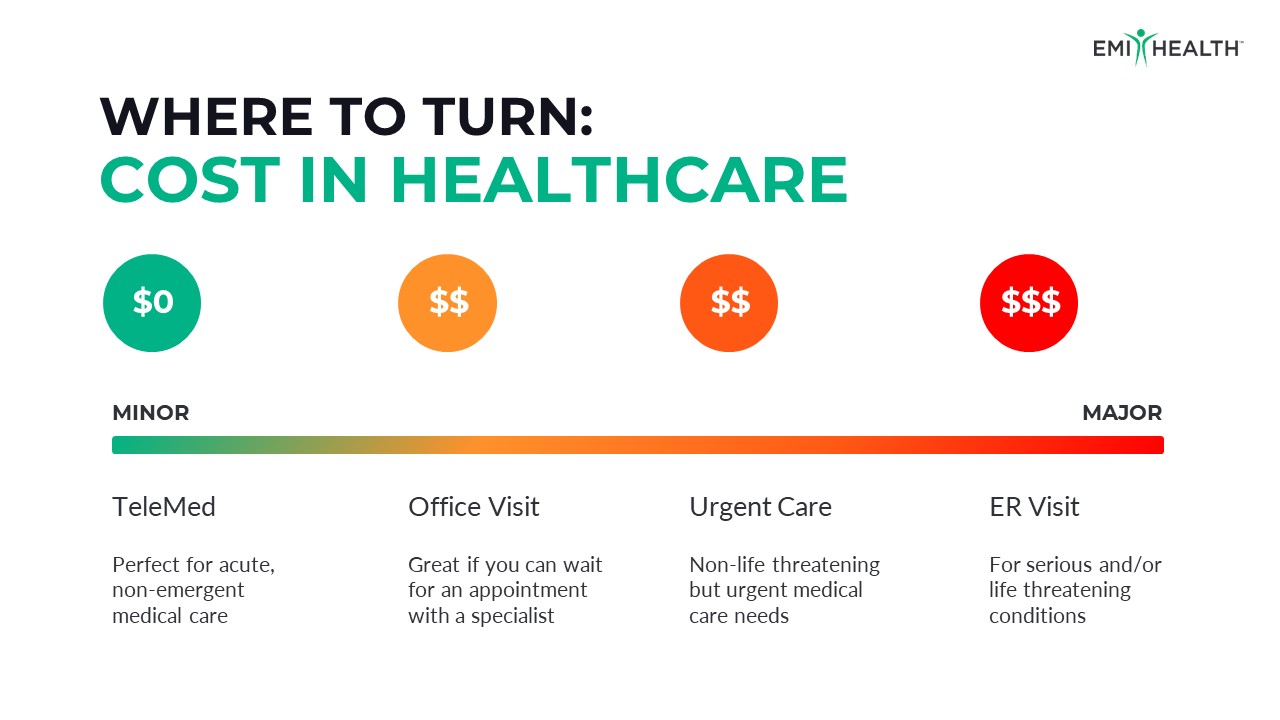If you need to slice an apple, you don't use a chainsaw. And if you need to chop an apple tree, you don't use a pocketknife. You find the right tool for the task ahead of you.
Using the right tool for getting medical attention is equally important. Going to the emergency room for strep throat might be unnecessary, and is probably costing you a lot more money and time than you need to be spending.
This article breaks it down for you. What kinds of illnesses and injuries can you call TeleMed for? When should you go to urgent care over the emergency room? And what things need to be seen by a specialist rather than a general practitioner?
Knowing the difference between services can save you time, inconvenience, and money. We're talking hundreds to thousands of dollars here... it's worth the read.
Telemedicine: Perfect for acute, non-emergent medical care.
Some 70% of doctor visits could be handled over the phone while you hang out in PJs on the couch, as well as about 40% of urgent care or emergency room visits. Telemedicine services usually allow you to get consultations the same day, often within the same hour as you request it. You can talk to a board-certified doctor anytime, anywhere without having to join a dating app. Or drive anywhere. Win - win.
TeleMed can also be used for advice on whether you should seek more advanced services. A short consultation over the phone may help you decide if you should go see a specialist or if you need to take a trip to the urgent care clinic. As long as you are not experiencing a life-threatening situation, it's a good idea to call TeleMed first.
Depending on your carrier, you could have little to no cost for a consultation and you can receive a diagnosis and prescription for many common illnesses such as:
- Allergies
- Asthma
- Bronchitis
- Cold or Flu
- Ear Ache
- Fever
- Heartburn
- Nausea
- Rash
- Sinus Infection
- Sore Throat
Office Visit: Best if you need a specialist.
Sprains, back pain, minor cuts or burns, and minor eye injuries are good examples of conditions where a visit to your primary care provider is your best option. These are conditions where you might need to be seen by a specialist in that area, but you can wait a few days for an available appointment.
Use office visits for care regarding chronic illness management, pregnancy, persistent pain, mental health needs, or other concerns that are not immediate needs and require more in-depth testing and diagnosis.
Urgent Care: Non-life threatening, but urgent needs.
Urgent Care facilities give you the convenience of extended hours and a much lower cost than the ER for many urgent medical situations. Stitches, sprains, x-rays, minor broken bones, and lab work can be handled at most Urgent Care facilities.
Also, if you need diagnostic testing done for ear infections, influenza, strep throat, or pneumonia you can go to urgent care clinics. Make sure to protect yourself and others by practicing good hygiene and wearing a face mask if you suspect you have a contagious illness.
Emergency Room: Life threatening illness or injury.
ERs are set up for the most serious cases. While they can diagnose and prescribe medication for routine illness, they will prioritize the most serious cases first. This means you may have to wait longer for your care, and you will likely pay a lot more because the emergency room's expenses are higher for supplies and staffing.
But if you have something life-threatening, don't hesitate to visit the ER. Go there if you experience:
- Trouble Breathing
- Sudden, unusual headache
- Signs of stroke
- Severe chest pain
- Heavy bleeding
- Deep wound
- Seizure
- Head or spine injury
- Broken bones
No matter what you are experiencing, make sure to act promptly to get the medical care you need. Knowing where to go for what though can help you to get quality care without unnecessary spending. You can save AND get taken care of quickly. That way all you have to worry about is feeling better.

This graphic is a helpful summary of everything discussed before.